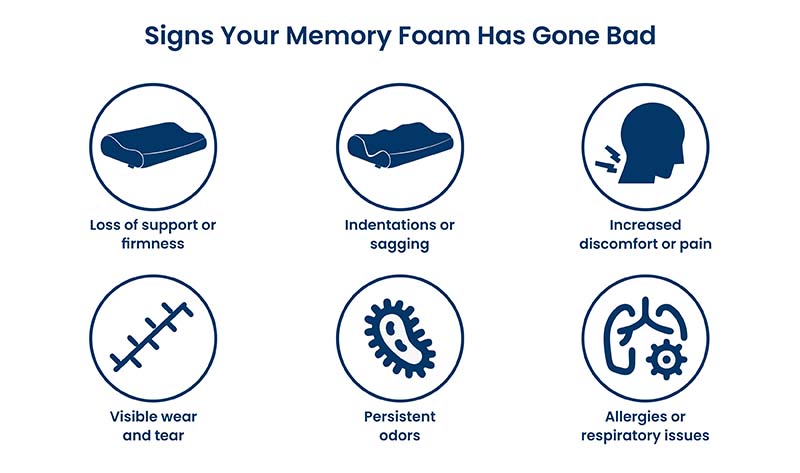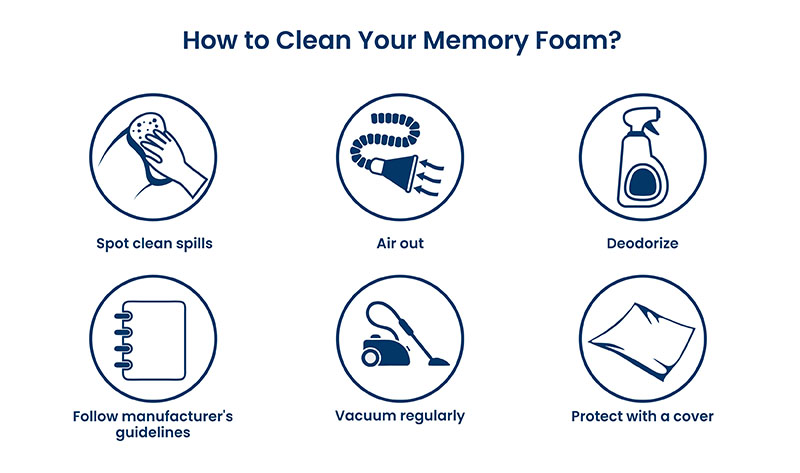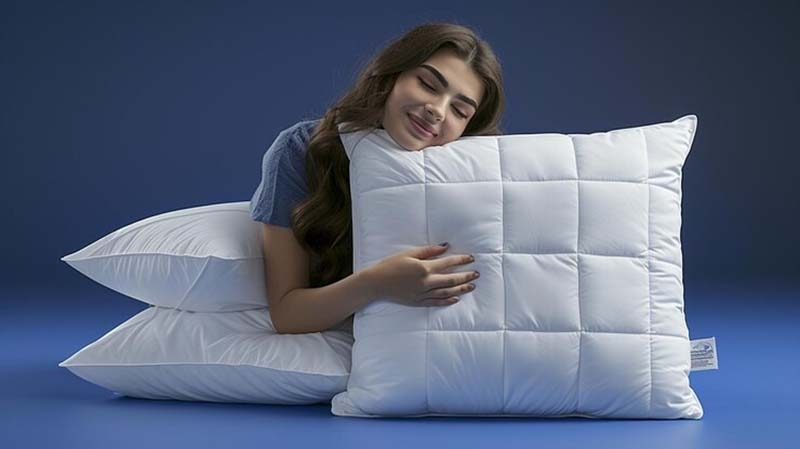Does your memory foam mattress no longer feel comfortable anymore? Have you noticed changes in its support and shape? You might have a crappy memory foam, and you need to take care of that before it starts messing up your sleep. We'll discuss the signs to look out for when determining if your memory foam is going bad and what you can do to fix the problem.
What to Look Out for?
Memory foam has a life expectancy, but it eventually wears out. Pay attention to signs that your memory foam is going bad and can no longer provide you with a good night's sleep.
Some indications that your memory foam pillow or mattress is not as supportive or comfortable as it used to be are:
1. Visible sagging or indentations
Memory foam can adjust to the shape of your body and return to its original form when it is not used. On the other hand, when it ages, the foam can lose shape and be characterized by dips and sagging spots. This may make you feel uneasy and cause your body to get poor support, causing you to wake up with aches and pains.
2. Lumps or uneven surface
Aside from sagging, your memory foam pillows or mattresses can also develop lumps and an uneven surface. This may result from regular usage and mishandling, such as not turning the mattress frequently. Not turning your mattress often enough does not just make your memory foam less comfy; it also affects how long it lasts.
3. Difficulties getting comfortable
The primary benefit of memory foam is its ability to contour your body and provide personalized support. If you keep changing your movement and trying to locate a relaxed place, your memory foam might eventually lose its ability to adapt to your body. This could indicate that you need to change your mattress or pillow.

4. Body aches and pains
As mentioned above, worn-out memory foam can cause discomfort, especially in the neck, shoulders, and back, because it does not support the body and relieve pressure points. So, if you observe that the discomfort or pain is becoming more aggravated, you should also get rid of your old memory foam.
5. Unpleasant odors
Memory foams are known for having a chemical-like smell when they are newly unpacked. The term for this phenomenon is off-gassing. The scent may also persist, which could be another indication that the foam is worn out. Mold or bacteria might be able to grow inside the foam and produce an odor that smells like a musty room. This situation can harm your health, so if your memory foam develops a musty smell, consider replacing it.
6. Allergies or respiratory issues
People prone to allergies or breathing problems may have more severe ailments when sleeping on an old, damaged memory foam mattress or pillow. This is likely because the foam contains more allergens, such as dust mites, mold, and other harmful substances. Getting a new mattress or pillow is good if you observe signs of sneezing, watery eyes, or breathing difficulties while resting on your memory foam.
How Long Does Memory Foam Last?
The durability of memory foam goods differs due to many factors, such as foam quality, how often they are used, and how they are maintained. For the most part, memory foam mattresses of good quality can last anywhere from 8 to 10 years, while the ones of lower quality can survive a maximum of 5 to 6 years.
The foam quality is the most important factor in determining its lifespan. Higher-quality memory foam is made of denser materials that provide better support and have a longer life. However, cheaper memory foam may use lower-density materials that deteriorate faster and lose shape. Look for high-density foam memory products whenever you shop; you will get a long-lasting product.
Alongside wear and tear, the frequency of use is another significant factor that can alter the lifespan of memory foam. A memory foam mattress used consistently would wear out faster than the one used intermittently, for example, in a guest room. The same rule can be applied to the pillow used. The latter will require a replacement less frequently than used every night.
Proper handling and maintenance also ensure the durability of memory foam products. The manufacturer's care instructions, such as rotating the mattress regularly, can help increase the mattress's life span.
Furthermore, a mattress protector can protect the foam from spills, stains, and dirt, thus preventing premature damage. Besides that, exposing memory foam products to high or low temperatures should be avoided, as these factors can lead to the degradation of the foam and its loss of shape.

How Does a Bad Memory Foam Affect Your Health?
A deteriorating memory foam mattress or pillow can affect your health in several ways:
- Poor Support: Memory foam, as it ages, becomes less adaptable; therefore, it may lose proper support. Which, in turn, can result in misaligned spinal, a reason for back and neck pain over time.
- Increased Allergens: Old memory foam can be a nest for dust mites, mold, and other harmful allergens, even if it is not covered correctly or maintained. Such allergens cause respiratory diseases and allergies.
- Heat Retention: Memory foam constructions that are used for a long time become more heat-retaining, thereby increasing the chances of a person staying awake at night. This can lead to problems like insomnia or sleep pattern disturbances.
- Pressure Points: Used-up memory foam can be a poor weight distribution material for body parts to high-pressure zones, resulting in discomfort and possibly circulation issues.
- Hygiene Concerns: Memory foam is susceptible to bacteria and their growth due to absorbing sweat, oils, and other bodily fluids over time. As a result, the skin may be irritated, and infections may develop.
Tips to Extend the Lifespan of Your Memory Foam
To extend the lifespan of your memory foam mattress or pillow, consider these tips:
Use a Mattress Protector: A waterproof and breathable mattress protector can help increase your memory foam's lifespan by shielding it against spills, stains, and moisture that could harm the material if absorbed for a long time.
Rotate and Flip Regularly: If your memory foam mattress allows it, rotate it 180 degrees every 3-6 months so that it wears evenly and eliminates sagging in one area.
Avoid Jumping or Standing: Memory foam is made for pressure relief and fitting to the body. Don't jump or stand on the foam, which may strain the material and cause it to wear out faster.
Keep It Clean: The matting of your mattress and pillows should be regularly vacuumed to suck out dust and debris. To clean your memory foam for stains, follow the spot-cleaning technique using a mild detergent and water, and let it air dry completely.
Proper Support: Make sure your memory foam mattress is on a sturdy base or mattress frame that provides enough support. This will prevent problems like sagging and the foam from losing its shape in the future.
Temperature Control: Memory foam is notorious for retaining heat. Use breathable bedding and a comfortable room temperature to reduce heat retention and still feel comfortable.
Air It Out: Give a break to your memory foam mattress or pillow by airing it out by taking off the sheets or covers and opening windows. This reduces the smell and moisture that are stuck in the air.
Follow Manufacturer Guidelines: Different memory foam products might have different care instructions. Follow the rules to maximize life and warranty coverage.
Final Thoughts
Uphold the quality and life span of your memory foam mattress or pillow to enjoy comfort and appropriate health. According to the manual, it is imperative to detect signs of wear, such as sagging, lumps, or discomfort, before sleeping. This is important for replacing the support system to get you the comfort you need to sleep peacefully.
Regular rotation, using a mattress protector, and following the manufacturer's care guidelines can significantly increase your mattress's lifetime. A deteriorating memory foam product affects sleep quality and can worsen health problems such as allergies and alternative causes due to poor support and increased allergens.
If you were more careful about your memory pillow's condition, for example, cleaning it constantly, avoiding excessive load, and controlling the temperature, you would extend its life. Remember, investing in high-quality memory foam and maintaining it properly will ultimately contribute to your well-being and ensure a more comfortable and supportive sleep environment.













